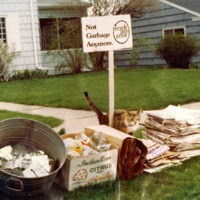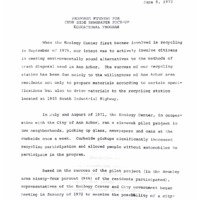Curbside Recycling
By the summer of 1971, Ann Arbor citizens could recycle their glass bottles, newspapers, and metal cans at the Ecology Center’s two drop-off recycling stations. Although the stations had many regular visitors, the staff of the Ecology Center realized that many more people would participate if the Center’s recycling operation could travel to them. In July and August 1971, the Ecology Center worked with the city to operate a curbside recycling pilot program in two neighborhoods in west and northeast Ann Arbor.
Before the pilot program began, Recycling Chairman Russ Linden explained how it would work to the Ann Arbor News. “We have selected two compact, diverse areas in Ann Arbor, and through leafletting and personal contact with the homeowners in those areas, have asked them to put their recyclable items on the curb a day ahead of their normal trash collection.” Using trucks supplied by the Department of Public Works, volunteers in the Neighborhood Youth Corps collected residents’ newspapers, glass, and cans. The Ecology Center launched an educational campaign and kept track of household participation. At the end of the six-week program, 95% of households in one neighborhood and 55% in the other had participated at least once. They collected a total of 36,000 pounds of recyclable materials.
Impressed by the pilot program’s success, Ann Arbor City Council created the Task Force on Recycling in February 1972 to consider establishing a city-run curbside recycling service. The Task Force, composed of several City Councilmembers and Ecology Center representatives, proposed a program to pick up bundled newspapers. Newsprint was easy to collect and had high returns, but they projected that starting the program would be expensive. However, due to the financial strain of a recession in the mid-1970s, the city failed to establish a curbside recycling program.


